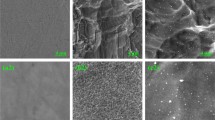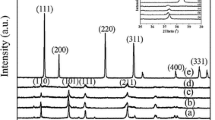Abstract
Looseness and infection are the two main reasons for failure of titanium (Ti) based implants (TBI), and offering TBI with superb osteogenesis and bactericidal effects is especially promising for orthopedic applications. Herein, a micro-arc oxidation (MAO) coating including germanium oxide (GeO2), tantalum oxide (Ta2O5) and titanium dioxide (TiO2) on Ti (MTG) surface was created through simultaneous dispersing Ge and Ta particles in the basic electrolyte. In comparison with Ti, the simultaneous deposition of Ge and Ta particles onto the MAO coating led to the change of surface characters (e.g., topography, hydrophilicity, roughness, and protein absorption) of MTG. Moreover, MTG exhibited exceptional corrosion resistance because of presence of Ta2O5. In addition, MTG significantly facilitated the cell response (e.g., attachment, multiplication, and osteoblastic differentiation) due to the existence of Ta2O5. Further, MTG revealed excellent bactericidal capability, which was ascribed to the sustained-release of Ge ions from the MAO coating. Accordingly, simultaneous deposition of Ge and Ta particles onto the MAO coating resulted in a novel implantable biomaterial of MTG with illustrious osteogenic and antibacterial capability as well as corrosion resistance. In short, MTG with excellent cytocompatibility possessed great potential for dental and load-bearing bone replacements.
Graphical abstract













Similar content being viewed by others
References
Chen QZ, Thouas GA (2015) Metallic implant biomaterials. Mat Sci Eng R 87:1–57. https://doi.org/10.1016/j.mser.2014.10.001
Kaur M, Singh K (2019) Review on titanium and titanium based alloys as biomaterials for orthopaedic applications. Mat Sci Eng C Mater 102:844–862. https://doi.org/10.1016/j.msec.2019.04.064
Yuan Z, He CC, Liu P, Cai KY (2021) Antibacterial surface design of biomedical titanium materials for orthopedic applications. J Mater Sci Technol 78:51–67. https://doi.org/10.1016/j.jmst.2020.10.066
Geetha M, Singh AK, Asokamani R, Gogia AK (2009) Ti based biomaterials, the ultimate choice for orthopaedic implants—a review. Prog Mater Sci 54:397–425. https://doi.org/10.1016/j.pmatsci.2008.06.004
Liu XY, Chu PK, Ding CX (2004) Surface modification of titanium, titanium alloys, and related materials for biomedical applications. Mat Sci Eng R 47:49–121. https://doi.org/10.1016/j.mser.2004.11.001
Chouirfa H, Bouloussa H, Migonney V, Falentin-Daudré C (2019) Review of titanium surface modification techniques and coatings for antibacterial applications. Acta Biomater 83:37–54. https://doi.org/10.1016/j.actbio.2018.10.036
Bauer S, Schmuki P, Von-Der-Mark K, Park J (2013) Engineering biocompatible implant surfaces Part I: materials and surfaces. Prog Mater Sci 58:261–326. https://doi.org/10.1016/j.pmatsci.2012.09.001
Tang JC, Wu ZZ, Yao XY, Zhou YH, Xiong Y, Li YL, Xu JY, Dargusch MS, Yan M (2022) From bio-inertness to osseointegration and antibacterial activity: A one-step micro-arc oxidation approach for multifunctional Ti implants fabricated by additive manufacturing. Mater Des 221:110962. https://doi.org/10.1016/j.matdes.2022.110962
Santos-Coquillat A, Tenorio RG, Mohedano M, Martinez-Campos E, Arrabal R, Matykina E (2018) Tailoring of antibacterial and osteogenic properties of Ti6Al4V by plasma electrolytic oxidation. Appl Surf Sci 454:157–172. https://doi.org/10.1016/j.apsusc.2018.04.267
Wang H, Su KX, Su LZ, Liang PP, Ji P, Wang C (2019) Comparison of 3D-printed porous tantalum and titanium scaffolds on osteointegration and osteogenesis. Mat Sci Eng C-Mater 104:109908. https://doi.org/10.1016/j.msec.2019.109908
Gao HR, Yang JZ, Jin X, Qu XH, Zhang FQ, Zhang DC, Chen HS, Wei HL, Zhang SP, Jia WT, Yue B, Li XP (2021) Porous tantalum scaffolds: Fabrication, structure, properties, and orthopedic applications. Mater Des 210:110095. https://doi.org/10.1016/j.matdes.2021.110095
Mei SQ, Yang LL, Pan YK, Wang DQ, Wang XH, Tang TT, Wei J (2019) Influences of tantalum pentoxide and surface coarsening on surface roughness, hydrophilicity, surface energy, protein adsorption and cell responses to PEEK based biocomposite. Colloid Surf B 174:207–215. https://doi.org/10.1016/j.colsurfb.2018.10.081
Wei XW, Liu BY, Liu G, Yang F, Cao F, Dou XJ, Yu WT, Wang BJ, Zheng GS, Cheng LL, Ma ZJ, Zhang Y, Yang JH, Wang ZH, Li JL, Cui DP, Wang W, Xie H, Li L, Zhang F, Lineaweaver WC, Zhao DW (2019) Mesenchymal stem cell-loaded porous tantalum integrated with biomimetic 3D collagen-based scaffold to repair large osteochondral defects in goats. Stem Cell Res Ther 10:72. https://doi.org/10.1186/s13287-019-1176-2
Hu XL, Mei SQ, Wang F, Qian J, Xie D, Zhao J, Yang LL, Wu ZY, Wei J (2021) Implantable PEKK/tantalum microparticles composite with improved surface performances for regulating cell behaviors, promoting bone formation and osseointegration. Bioact Mater 6:928–940. https://doi.org/10.1016/j.bioactmat.2020.09.021
Liu BY, Ma ZJ, Li JL, Xie H, Wei XW, Wang BJ, Tian SM, Yang JH, Yang L, Cheng LL, Li L, Zhao DW (2021) Experimental study of a 3D printed permanent implantable porous Ta-coated bone plate for fracture fixation. Bioact Mater 10:269–280. https://doi.org/10.1016/j.bioactmat.2021.09.009
Dinjaski N, Suri S, Valle J, Lehman SM, Lasa I, Prieto MA, García AJ (2014) Near-infrared fluorescence imaging as an alternative to bioluminescent bacteria to monitor biomaterial-associated infections. Acta Biomater 10:2935–2944. https://doi.org/10.1016/j.actbio.2014.03.005
Mas-Moruno C, Su B, Dalby MJ (2019) Multifunctional coatings and nanotopographies: toward cell instructive and antibacterial implants. Adv Healthc Mater 8:1801103. https://doi.org/10.1002/adhm.201801103
Li ZS, Liu H, Xu X, Ma LN, Shang SB, Song ZQ (2020) Surface modification of silicone elastomer with rosin acid-based quaternary ammonium salt for antimicrobial and biocompatible properties. Mater Des 189:108493. https://doi.org/10.1016/j.matdes.2020.108493
Dobrzyński D, Boguszewska-Czubara A, Sugimori K (2018) Hydrogeochemical and biomedical insights into germanium potential of curative waters: a case study of health resorts in the Sudetes Mountains (Poland). Environ Geochem Hlth 40:1355–1375. https://doi.org/10.1007/s10653-017-0061-0
Ge M, Zong M, Xu D, Chen Z, Yang J, Yao H, Wei C, Chen Y, Lin H, Shi J (2021) Freestanding germanene nanosheets for rapid degradation and photothermal conversion. Mater Today Nano 15:100119. https://doi.org/10.1016/j.mtnano.2021.100119
Kurt MS, Arslan ME, Yazici A, Mudu I, Arslan E (2021) Tribological, biocompatibility, and antibiofilm properties of tungsten-germanium coating using magnetron sputtering. J Mater Sci-Mater M 32:6. https://doi.org/10.1007/s10856-020-06477-4
Chen Z, Ke HZ, Wang J, Li YG, Jia H, Wei QF (2022) Novel germanium-polyamide6 fibers with negative air ions release and far-infrared radiation as well as antibacterial property. Text Res J 92:1739–1747. https://doi.org/10.1177/00405175211068369
Arslan ME, Kurt MS, Aslan N, Kadi A, Oner S, Cobanoglu S, Yazici A (2022) Structural, biocompatibility, and antibacterial properties of Ge-DLC nanocomposite for biomedical applications. J Biomed Mater Res B 110:1667–1674. https://doi.org/10.1002/jbm.b.35027
Fan JY, Chu PK (2010) Group IV Nanoparticles: synthesis, properties, and biological applications. Small 6:2080–2098. https://doi.org/10.1002/smll.201000543
Yuan Z, Tao BL, He Y, Liu J, Lin CC, Shen XK, Yu YL, Mu CY, Liu P, Cai KY (2019) Biocompatible MoS2/PDA-RGD coating on titanium implant with antibacterial property via intrinsic ROS-independent oxidative stress and NIR irradiation. Biomaterials 217:119290. https://doi.org/10.1016/j.biomaterials.2019.119290
Bian D, Zhou WR, Deng JX, Liu Y, Li WT, Chu X, Xiu P, Cai H, Kou YH, Jiang BG, Zheng YF (2017) Development of magnesium-based biodegradable metals with dietary trace element germanium as orthopaedic implant applications. Acta Biomater 64:421–436. https://doi.org/10.1016/j.actbio.2017.10.004
Zhou YL, Niinomi M (2009) Ti-25Ta alloy with the best mechanical compatibility in Ti-Ta alloys for biomedical applications. Mat Sci Eng C Mater 29:1061–1065. https://doi.org/10.1016/j.msec.2008.09.012
Gao Y, Wang SQ, Yang CY, An N, Liu Z, Yan M, Guo CS (2019) A near-infrared responsive germanium complex of Ge/GeO2 for targeted tumor phototherapy. J Mater Chem B 7:5056–5064. https://doi.org/10.1039/C9TB00548J
Li Y, Zhao TT, Wei S, Xiang Y, Chen H (2010) Effect of Ta2O5/TiO2 thin film on mechanical properties, corrosion and cell behavior of the NiTi alloy implanted with tantalum. Mat Sci Eng C Mater 30:1227–1235. https://doi.org/10.1016/j.msec.2010.07.001
He S, Duan CY, Wang S, Yu Y, Chan YK, Shi XY, Huang JH, Wang ST, Peng SJ, Deng Y (2022) Fusion peptide-engineered polyetheretherketone implants with photo-assisted anti-pathogen and enhanced angiogenesis for in vivo osseointegrative fixation. Chem Eng J 446:137453. https://doi.org/10.1016/j.cej.2022.137453
Liu ZG, Liu Y, Liu S, Wang DX, Jin J, Sun LD, Wang Q, Yi Z (2021) The effects of TiO2 nanotubes on the biocompatibility of 3D printed Cu-bearing TC4 alloy. Mater Des 207:109831. https://doi.org/10.1016/j.matdes.2021.109831
Asadullah S, Mei SQ, Wang DQ, Yao Y, Pan YK, Wang DL, Guo H, Wei J (2020) Sulfonated porous surface of tantalum pentoxide/polyimide composite with micro-submicro structures displaying antibacterial performances and stimulating cell responses. Mater Des 190:108510. https://doi.org/10.1016/j.matdes.2020.108510
Li CY, Yu C, Zeng RC, Zhang BC, Cui LY, Wan J, Xia Y (2019) In vitro corrosion resistance of a Ta2O5 nanofilm on MAO coated magnesium alloy AZ31 by atomic layer deposition. Bioact Mater 5:34–43. https://doi.org/10.1016/j.bioactmat.2019.12.001
Zhang H, Liu K, Lu MM, Liu L, Yan YZ, Chu ZZ, Ge YR, Wang T, Qiu J, Bu SS, Tang CB (2021) Micro/nanostructured calcium phytate coating on titanium fabricated by chemical conversion deposition for biomedical application. Mat Sci Eng C Mater 118:111402. https://doi.org/10.1016/j.msec.2020.111402
Ji YJ, Zhang HC, Ru JY, Wang F, Xu M, Zhou QR, Stanikzai H, Yerlan I, Xu ZY, Niu YF, Wei J (2021) Creating micro-submicro structure and grafting hydroxyl group on PEEK by femtosecond laser and hydroxylation to synergistically activate cellular response. Mater Des 199:109413. https://doi.org/10.1016/j.matdes.2020.109413
Zhou XF, Cheng X, Xing DL, Ge Q, Li Y, Luan XH, Gu N, Qian YZ (2021) Ca ions chelation, collagen I incorporation and 3D bionic PLGA/PCL electrospun architecture to enhance osteogenic differentiation. Mater Des 198:109300. https://doi.org/10.1016/j.matdes.2020.109300
Hou FS, Jiang W, Zhang Y, Tang JC, Li D, Zhao B, Wang L, Gu Y, Cui WG, Chen L (2022) Biodegradable dual-crosslinked adhesive glue for fixation and promotion of osteogenesis. Chem Eng J 427:132000. https://doi.org/10.1016/j.cej.2021.132000
Sun JY, Wei L, Liu XY, Li JY, Li BE, Wang GC, Meng FH (2009) Influences of ionic dissolution products of dicalcium silicate coating on osteoblastic proliferation, differentiation and gene expression. Acta Biomater 5:1284–1293. https://doi.org/10.1016/j.actbio.2008.10.011
Zhang YL, Chen LJ, Liu CD, Feng XL, Wei LM, Shao LQ (2016) Self-assembly chitosan/gelatin composite coating on icariin-modified TiO2 nanotubes for the regulation of osteoblast bioactivity. Mater Des 92:471–479. https://doi.org/10.1016/j.matdes.2015.12.023
Yu WZ, Zhang YZ, Liu XM, Xiang YM, Li ZY, Wu SL (2018) Synergistic antibacterial activity of multi components in lysozyme/chitosan/silver/hydroxyapatite hybrid coating. Mater Des 139:351–362. https://doi.org/10.1016/j.matdes.2017.11.018
Fialho L, Grenho L, Fernandes MH, Carvalho S (2021) Porous tantalum oxide with osteoconductive elements and antibacterial core-shell nanoparticles: a new generation of materials for dental implants. Mat Sci Eng C Mater 120:111761. https://doi.org/10.1016/j.msec.2020.111761
Chung J, Lee S (2014) Development of nanofibrous membranes with far-infrared radiation and their antimicrobial properties. Fibers Polym 15:1153–1159. https://doi.org/10.1007/s12221-014-1153-4
Li YL, Xiao Y, Liu CS (2017) The horizon of materiobiology: a perspective on material-guided cell behaviors and tissue engineering. Chem Rev 117:4376–4421. https://doi.org/10.1021/acs.chemrev.6b00654
Acknowledgements
The grants were from the National Natural Science Foundation of China (81772343, 32171340), Natural Science Foundation of Jilin Province (YDZJ202201ZYTS281) and Finance Department of Jilin Province, P.R. China (G. No. 3D5197435429).
Author information
Authors and Affiliations
Contributions
Conceptualization, W.J. and Y.Z.; Data curation, Y.H. and X.W.; Formal analysis, W.J.; Investigation, W.J. and Y.S.; Methodology, W.J. and F.W.; Project administration, Y.Z.; Resources, Y.H.; Supervision, Y.Z.; Validation, F.W. and X.Z.; Writing—original draft, W.J. and Y.S.; Writing—review & editing, J.W. and Y.Z.
Corresponding author
Ethics declarations
Competing interests
The authors declare that they have no known competing financial interests or personal relationships that could have appeared to influence the work reported in this paper.
Additional information
Handling Editor: Stephen Eichhorn.
Publisher's Note
Springer Nature remains neutral with regard to jurisdictional claims in published maps and institutional affiliations.
Rights and permissions
Springer Nature or its licensor (e.g. a society or other partner) holds exclusive rights to this article under a publishing agreement with the author(s) or other rightsholder(s); author self-archiving of the accepted manuscript version of this article is solely governed by the terms of such publishing agreement and applicable law.
About this article
Cite this article
Jiang, W., Sun, Y., Wang, F. et al. An anti-corrosion MAO coating containing germanium dioxide and tantalum pentoxide on titanium surface for facilitating osteoblastic differentiation and killing bacteria. J Mater Sci 58, 18169–18186 (2023). https://doi.org/10.1007/s10853-023-09186-9
Received:
Accepted:
Published:
Issue Date:
DOI: https://doi.org/10.1007/s10853-023-09186-9




